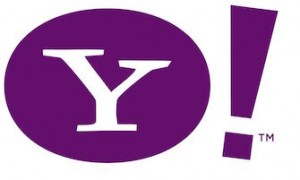 Headquartered in Sunnyvale, CA, Yahoo! Inc. (YHOO) is a multinational corporation focused on delivering Internet and media services to online consumers. Its various web services include social media, news, search engine, online mapping, group forums and a question answering service.
Headquartered in Sunnyvale, CA, Yahoo! Inc. (YHOO) is a multinational corporation focused on delivering Internet and media services to online consumers. Its various web services include social media, news, search engine, online mapping, group forums and a question answering service.
The research and development activities of this corporation have been the topic of much discussion since the July 2012 appointment of former Google executive Marissa Mayer as Yahoo!’s president and CEO. Many have speculated that the move might be a harbinger of open innovation practices at Yahoo!, even though some commentators have argued that open innovation may prove to be too unfocused to support business success for Yahoo! Between July 2011 and July 2014, Yahoo! had expenditures of 17.8 as a percent of sales on R&D while experiencing a stock growth of 85 percent over the same time period. Areas of research focus at Yahoo! Labs include computational advertising, machine learning and web mining innovations. Reports in October of last year indicated that Google acquired a total of 55 of Yahoo!’s patents in mapping, online search and other digital technologies.
In 2013, Yahoo! had already engaged in a sizable sale of patents from its portfolio to Alibaba which earned the company $70 million. More recently, however, Yahoo! has been dealing with a series of ups and downs as it attempts to divest itself of its holdings in the Chinese e-commerce company, in which Yahoo! held a $39 billion stake. The tax-free move will save Yahoo! shareholders about $16 billion, which sent stock prices up by eight percent shortly after the announcement of the deal in late January. However, poorly performing Alibaba stock caused Yahoo! shares to lose those gains, and then some, within just a few days.
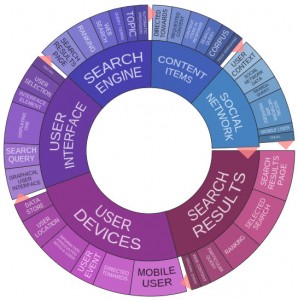 The 2014 patenting activities of Yahoo! did not land it among the top 50 U.S. patent grant recipients, as determined by IFI Claims. In 2013, the company placed 113th overall with a total of 312 U.S. patents granted by the U.S. Patent and Trademark Office.
The 2014 patenting activities of Yahoo! did not land it among the top 50 U.S. patent grant recipients, as determined by IFI Claims. In 2013, the company placed 113th overall with a total of 312 U.S. patents granted by the U.S. Patent and Trademark Office.
Our research using the Innography patent analytics search tools shows a total of 303 U.S. patent grants during 2014; the text cluster diagram (shown right) gives us a quick glimpse into those patents, not surprisingly showing that much of Yahoo!’s patent activity was focused on search engine services, especially in selected searches and search result pages. User devices, user interfaces and social networking also represented an important focus for Yahoo! in 2014.
Yahoo!’s Issued Patents: Fantasy Sports, Dynamic Social Networking and Search Engine Tech
A pair of patents that we wanted to share today protect technologies which support highly effective search engines. A system for reducing frustration in search engine users by providing more personalized responses to search queries is at the center of U.S. Patent No. 8903845, entitled Systems and Methods for Providing Search Assistance Technologies Based on User Self-Efficacy and Search Frustration. The method protected here involves receiving a search query from a user, calculating both the user’s search self-efficacy as well as the level of frustration with the current information task, identifying a plurality of search assistance applications associated with a search self-efficacy and frustration level and determining if those applications are available to assist a user. This system is configured to provide suggestions on assisted search technologies in response to the determination that a user is becoming frustrated with a search process. Enhanced methods for displaying search engine result content on smaller mobile display screens is the focus of U.S. Patent No. 8923621, which is titled Finding Engaging Media With Initialized Explore-Exploit. The method claimed here involves creating probability distributions from a plurality of distinct images, the probability distributions generated by inputting a quantitative description of features associated with the plurality of images. These probability distributions provide a measure of engagingness for images that are conceptually related. The technology is intended to return search results that include relatively engaging data for images of less famous subjects which may not have the click-through data necessary to rank images using conventional methods.
More engaging systems for text messaging which utilize animated characters are disclosed and protected by U.S. Patent No. 8930463, issued under the title Super-Emoticons. This innovation is designed to produce an animated character with more sophisticated behaviors, such as interacting with textual elements, moving out of a fixed location within a message or exhibiting randomly selected behaviors. The patent claims a computer-implemented method of receiving a trigger string through a text input interface provided by a messaging client that causes the messaging client to generate an initial display of a string-triggered visual image.
More robust methods for determining the efficacy of online advertisements are featured within U.S. Patent No. 8935177, which is titled Method and System for Anonymous Measurement of Online Advertisement Using Offline Sales. This invention was pursued in order to address shortcomings in determining how online advertisements could affect the level of sales in brick and mortar establishments. The method claimed here involves maintaining a user data store for a plurality of users which stores personally identifiable information about corresponding users regarding their connection to an online advertisement campaign. The method further includes the generation of tokens for identifying a user’s exposure to an online ad campaign and to identify transactions associated with the user using offline sale transaction data.
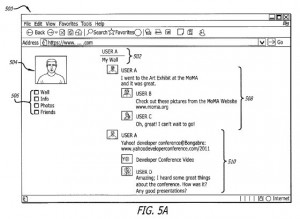 A dynamic method of social networking that presents information of interest to a person who visits another person’s social media page is described within U.S. Patent No. 8914382, which is titled System and Method for Generation of a Dynamic Social Page. The patent protects a method of receiving a request from a second user of a social network to visit a page associated with a first user, accessing an interest profile of the second user containing data corresponding to types of content which the second user has interacted with, accessing a social networking profile of a first user and determining interest scores and content scores for both users which are within a similar category. This innovation provides a dynamic solution for providing the social media content of greatest interest to specific users who visit another user’s social media profile.
A dynamic method of social networking that presents information of interest to a person who visits another person’s social media page is described within U.S. Patent No. 8914382, which is titled System and Method for Generation of a Dynamic Social Page. The patent protects a method of receiving a request from a second user of a social network to visit a page associated with a first user, accessing an interest profile of the second user containing data corresponding to types of content which the second user has interacted with, accessing a social networking profile of a first user and determining interest scores and content scores for both users which are within a similar category. This innovation provides a dynamic solution for providing the social media content of greatest interest to specific users who visit another user’s social media profile.
 Yahoo! is even earning patents in the sphere of online fantasy sports, as is evidenced by the recent issue of U.S. Patent No. 8876607, which is titled Visual Display of Fantasy Sports Team Starting Roster Data Trends. The apparatus of this invention includes a processor which executes program logic for statistics generation that determines a rendition of a plurality of statistics associated with at least one player on at least one team in an online fantasy sports game. This system is designed to enable fantasy sports service users to quickly make decisions regarding sports players on their roster by providing statistical information informing users of trends at a glance.
Yahoo! is even earning patents in the sphere of online fantasy sports, as is evidenced by the recent issue of U.S. Patent No. 8876607, which is titled Visual Display of Fantasy Sports Team Starting Roster Data Trends. The apparatus of this invention includes a processor which executes program logic for statistics generation that determines a rendition of a plurality of statistics associated with at least one player on at least one team in an online fantasy sports game. This system is designed to enable fantasy sports service users to quickly make decisions regarding sports players on their roster by providing statistical information informing users of trends at a glance.
Patent Applications of Note: From Online Shopping Recommendations to Motion-Based Human Verification
A trio of patent applications filed by Yahoo! within the field of shopping and marketing which showcase a strong focus on developing retail technologies for businesses. Brick and mortar establishments will be able to follow through on competitor price matching programs more effectively thanks to the invention described within U.S. Patent Application No. 20140337116, which is titled Marketing Technique to Negotiate Price of Product. The method claimed here involves retrieving price guarantee policies from one or more sellers which include price guarantee limits for one or more time periods during which price guarantee rebates can be obtained, as well as generating and sending offer for sale information for commodities to one or more buyers. Through this system, a customer can redeem a rebate offered through a price guarantee program for a tangible good or service which is offered on a gift card. Improvements to 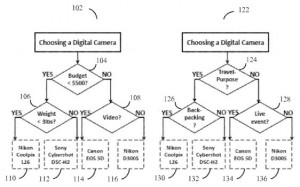 online shopping experiences are the focus of U.S. Patent Application No. 20140358720, entitled Method and Apparatus to Build Flowcharts for E-Shopping Recommendations. The method that would be protected involves building an advisor flowchart with a plurality of nodes associated with user attributes and a ranking of products, and using the advisor flowchart to identify a set of product recommendations for a user. This innovation is designed to provide more guidance to online shoppers attempting to find the right product among an incredibly vast catalog of products available online. Marketing techniques that take advantage of peer influence among customers are explored within U.S. Patent Application No. 20150019474, which is titled Influence Maximization With Viral Product Design. The patent application would protect a method of using a feature-aware propagation model for identifying a seed set of users who are members of a social network for influencing other social network users as well as a product feature set for a product which is more likely to be adopted by users of a social network. This innovation is intended to provide businesses with a means for exploiting social networks to increase sales or brand awareness in a viral manner.
online shopping experiences are the focus of U.S. Patent Application No. 20140358720, entitled Method and Apparatus to Build Flowcharts for E-Shopping Recommendations. The method that would be protected involves building an advisor flowchart with a plurality of nodes associated with user attributes and a ranking of products, and using the advisor flowchart to identify a set of product recommendations for a user. This innovation is designed to provide more guidance to online shoppers attempting to find the right product among an incredibly vast catalog of products available online. Marketing techniques that take advantage of peer influence among customers are explored within U.S. Patent Application No. 20150019474, which is titled Influence Maximization With Viral Product Design. The patent application would protect a method of using a feature-aware propagation model for identifying a seed set of users who are members of a social network for influencing other social network users as well as a product feature set for a product which is more likely to be adopted by users of a social network. This innovation is intended to provide businesses with a means for exploiting social networks to increase sales or brand awareness in a viral manner.
Other techniques for deriving more useful information from social networks about user relationships are discussed within U.S. Patent Application No. 20140337356, which is titled Identifying Communities Within a Social Network Based on Information Propagation Data. This innovation is intended to allow social network users and advertisers to more easily identify friendships among users, followers of a user or posts by a user. The method for identifying communities based on information propagation data claimed here includes receiving a social graph with nodes connected by relationships, receiving a number of communities to find within the social graph, receiving data regarding propagation of information between nodes, calculating the probability of a link between nodes based on the data and calculating a probability that media will be accessed by the second node based on the data.
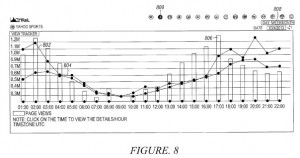 Advertisers looking to associate their ads with viral content that is reaching a large number of Internet users is the focus of U.S. Patent Application No. 20140344281, which is titled System and Method for Measuring the Virality of Internet Content Using Indices. The system for measuring the virality of content items on a network that would be protected involves a publisher server for providing a page comprising a content item, a referral server for providing user remote access to the content item, an indexer for measuring the performance of a content item and a logic generator for displaying a visual element that provides a graphical representation of the index score. This particular innovation is intended to provide website providers and advertisers with greater tools to track and monitor trends in user access requests to content items.
Advertisers looking to associate their ads with viral content that is reaching a large number of Internet users is the focus of U.S. Patent Application No. 20140344281, which is titled System and Method for Measuring the Virality of Internet Content Using Indices. The system for measuring the virality of content items on a network that would be protected involves a publisher server for providing a page comprising a content item, a referral server for providing user remote access to the content item, an indexer for measuring the performance of a content item and a logic generator for displaying a visual element that provides a graphical representation of the index score. This particular innovation is intended to provide website providers and advertisers with greater tools to track and monitor trends in user access requests to content items.
More fantasy sports innovations were on display for us within U.S. Patent Application No. 20150005072, which is titled Fantasy Sports With Situational Substitutions of Players. The method that would be protected includes maintaining a personnel package comprised of fantasy sports players on a fantasy sports team; the package is associated with a specific situation that might happen in a real life sports game and is used to inform substitutions for players on a fantasy sports team if it’s determined that the predetermined situation occurs in a real life game. This technique would enable fantasy sports team owners to accrue points based on how players perform in certain in-game situations, such as third-and-long or goal line situations in football games.
Finally, we were greatly intrigued in an authentication method that goes well beyond a typical CAPTCHA challenge-response test, outlined within U.S. Patent Application No. 20150007289, which is titled Motion-Based Human Verification System and Method. This method involves the selection of a challenge type for a human verification test, where the challenge types are pattern-based or image-based challenges, the determination of a challenge in accordance with a selected challenge type and the presentation of the challenge at a user device. This invention supports the use of unique human verification tests which may be more engaging to users, such as tracing a pattern in a three-dimensional space or completing a simple race car game.

![[IPWatchdog Logo]](https://ipwatchdog.com/wp-content/themes/IPWatchdog%20-%202023/assets/images/temp/logo-small@2x.png)

![[Advertisement]](https://ipwatchdog.com/wp-content/uploads/2024/04/Patent-Litigation-Masters-2024-sidebar-early-bird-ends-Apr-21-last-chance-700x500-1.jpg)

![[Advertisement]](https://ipwatchdog.com/wp-content/uploads/2021/12/WEBINAR-336-x-280-px.png)
![[Advertisement]](https://ipwatchdog.com/wp-content/uploads/2021/12/2021-Patent-Practice-on-Demand-recorded-Feb-2021-336-x-280.jpg)
![[Advertisement]](https://ipwatchdog.com/wp-content/uploads/2021/12/Ad-4-The-Invent-Patent-System™.png)







Join the Discussion
No comments yet.